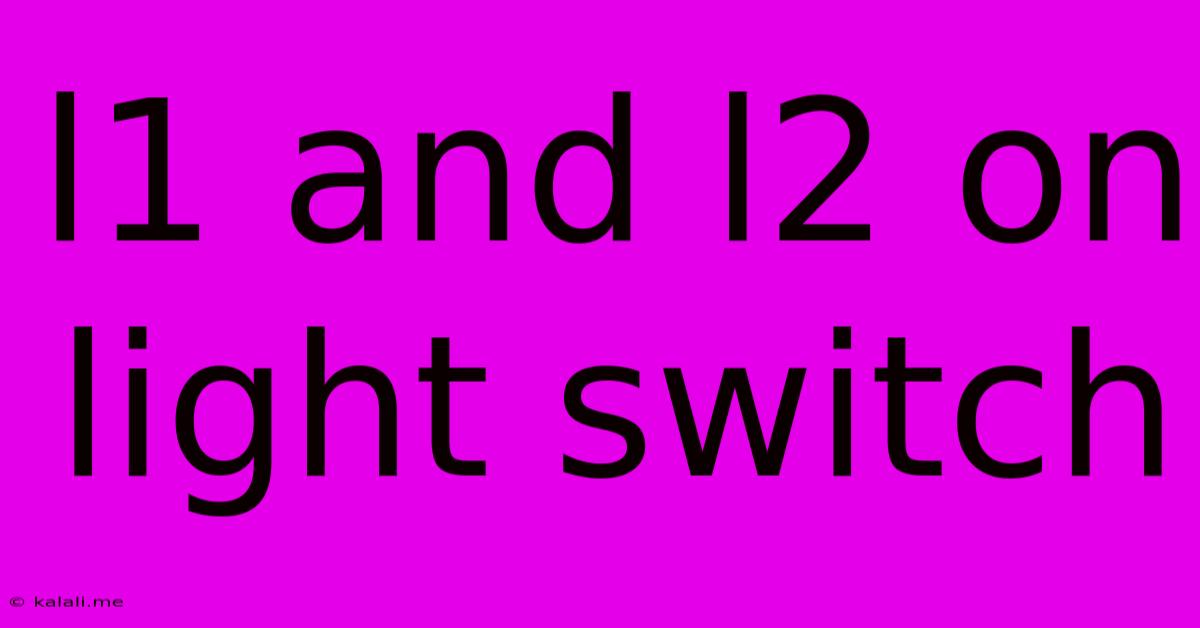L1 And L2 On Light Switch
Kalali
May 21, 2025 · 3 min read

Table of Contents
Understanding L1 and L2 on a Light Switch: A Comprehensive Guide
Meta Description: Confused about L1 and L2 on your light switch? This guide explains the meaning of L1 and L2 terminals, their function in different wiring configurations, and how to identify them safely. Learn about single-pole, three-way, and four-way switching systems.
Many homeowners encounter the mysterious markings "L1" and "L2" on their light switches and find themselves wondering what they mean. These terminals aren't just random labels; they are crucial for understanding how your electrical system is wired and how to safely install or troubleshoot your light switches. This article will demystify L1 and L2, explaining their function in various switching configurations.
What do L1 and L2 Mean?
L1 and L2 represent the live or hot wires carrying electrical current to your light switch. They are essentially different parts of the same electrical circuit, used to control the light from multiple locations. Let's break down how they function in different switch types:
-
Single-Pole Switch: In a simple single-pole switch configuration, controlling a light from a single location, you'll only need one live wire. This wire is typically connected to the L1 terminal. The L2 terminal might be present but unused in this scenario.
-
Three-Way Switch: Three-way switches allow you to control a light from two different locations. Here, L1 and L2 become essential. One hot wire connects to the L1 terminal of one three-way switch, while the other three-way switch receives the power via its L2 terminal. The common terminals between the two switches complete the circuit. This arrangement allows for switching the light on or off from either location.
-
Four-Way Switch: When you want to control a light from more than two locations, you incorporate four-way switches into the circuit. These switches work in conjunction with three-way switches. They don't have L1 and L2 terminals in the same way, instead relying on a different wiring arrangement to control the flow of electricity between the three-way switches.
Identifying L1 and L2 Terminals
It's crucial to identify these terminals correctly before working with any electrical wiring. Always turn off the power at the breaker before attempting any wiring work. Incorrect wiring can lead to electrical shock or damage to your electrical system.
Identifying the terminals is usually straightforward: Most switches clearly mark the L1 and L2 terminals. However, if markings are unclear or missing, consult the switch's documentation or seek assistance from a qualified electrician.
Common Misconceptions and Troubleshooting
- L1 and L2 aren't always used: As mentioned, single-pole switches might only utilize L1. Don't assume the presence of both terminals means they are always actively used.
- Incorrect wiring: If your light doesn't work correctly, double-check that L1 and L2 are connected appropriately based on your switching configuration. A simple wiring error can cause malfunction.
- Old Wiring: In older homes, wiring conventions might differ, making it crucial to carefully examine the circuit before attempting any modifications.
Safety Precautions
Electrical work can be dangerous. Always prioritize safety:
- Turn off the power: This is paramount before working with any electrical components.
- Use proper tools: Use insulated screwdrivers and other tools designed for electrical work.
- Consult a professional: If you are unsure about any aspect of your wiring, don't hesitate to call a qualified electrician.
Understanding L1 and L2 terminals on light switches is essential for safe and effective electrical work. By understanding their role in different wiring configurations, you can confidently tackle light switch installations and troubleshoot any issues that may arise. Remember to always prioritize safety and consult a professional when in doubt.
Latest Posts
Latest Posts
-
Walk From Euston To St Pancras
May 21, 2025
-
How Many Planets Are In No Mans Sky
May 21, 2025
-
What Are You Up To Now
May 21, 2025
-
How Long Does It Take Tile Grout To Dry
May 21, 2025
-
How To Plug A Guitar Into A Pc
May 21, 2025
Related Post
Thank you for visiting our website which covers about L1 And L2 On Light Switch . We hope the information provided has been useful to you. Feel free to contact us if you have any questions or need further assistance. See you next time and don't miss to bookmark.